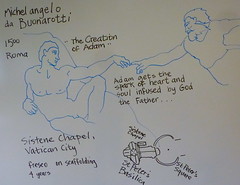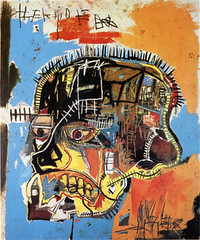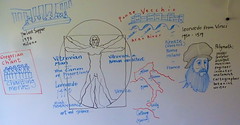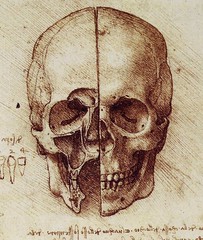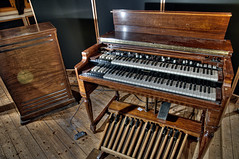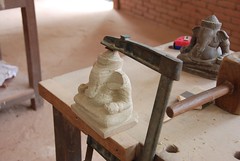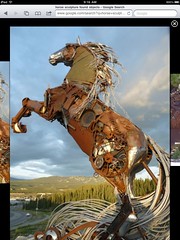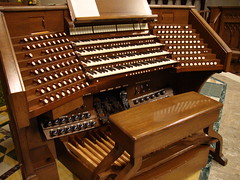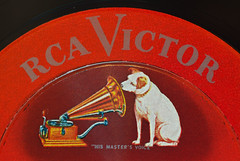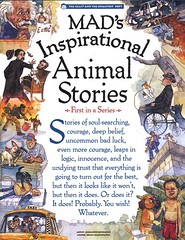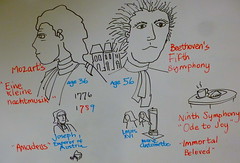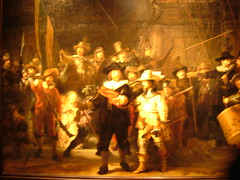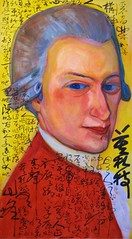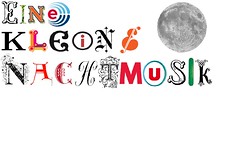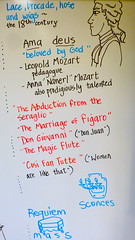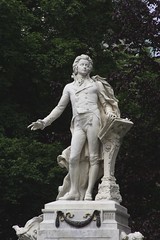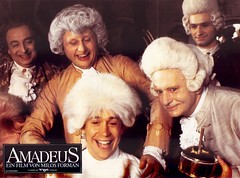Tuesday, April 30, 2013
Senior exam: one-page comparison essay on 2 artists, such as Basquiat and Kahlo
Any of the artists we've studied in fine arts survey!
- titles
- dates
- locations
- third person
- scholarly tone
- documentation
- jazzy title
- titles
- dates
- locations
- third person
- scholarly tone
- documentation
- jazzy title
Tuesday, April 23, 2013
K'Naan, Alt-J and Youth Lagoon: music away from the mainstream
Off-the-beaten-path music presentations!
Red Baraat
Alt-J
Youth Lagoon
Alexander Rybak
Say a few biographical and explicatory words and play the video! 10 pts.
My favorite today was "Breezeblocks" by Alt-J. Stunning film.
Red Baraat
Alt-J
Youth Lagoon
Alexander Rybak
Say a few biographical and explicatory words and play the video! 10 pts.
My favorite today was "Breezeblocks" by Alt-J. Stunning film.
Monday, April 22, 2013
Leonardo da Vinci / Renaissance art
Leonardo Supper Quiz
1. Leonardo's equestrian statue, "Gran cavallo," was never cast in bronze though it inspired awe as a giant clay sculpture. The subject was a __ . a) prince b) eagle c) horse d) castle.
2. L was raised in the vicinity of the city that was a center of Renaissance arts from the 14th to 16th centuries, Firenze. Today Firenze, located on the famous Arno River, is known as __, which means "flower." a) Florence b) Bologna c) Venetia d) Roma.
3. In Firenze visitors find a Medieval enclosed bridge called the "__ Vecchio." This bridge integrated shops into the structure. Once the stores featured butchers; today the storefronts are occupied by jewelers and art dealers.
a) Regulare b) Ponte c) Duomo d) Arco.
4. As a young man L was apprenticed to a studio where he learned drafting, chemistry, metallurgy, metal working, plaster casting, leather working, mechanics and carpentry as well as the artistic skills of drawing, painting, sculpting and modelling. It was the workshop operated by the famous artist __ . a) Michelangelo b) Botticelli c) Ludovico il Moro d) Andrea del Verrocchio.
5. The Last Supper was painted for a __ . a) monastery b) library c) museum d) art gallery
6. The Last Supper is a mural. Such works were ordinarily painted via the style called __, in which paint is applied to wet plaster. a) watercolor b) pastel c) fresco d) relief.
7. The Last Supper is on display in the city of a) Milan b) Florence c) Roma d) Bologna.
8. The figures in Supper are __ life size. a) larger than b) one half c) three quarters.
9. Much of his work was not performed as an artist but as an architect and designer to aid his royal employers in their __ . a) religious duties b) wars c) public buildings d) personal residences.
10. Cesare Borgia's stronghold city, Imola, was celebrated and aided by a __ developed by Leonardo. a) canal b) map c) fortified wall d) system of wells.
11. Leonardo was a bastard, or illegitimate child. T / F
12. His life of 57 years surrounded the year of __ . a) 1300 b) 1400 c) 1500 d) 1600.
13. In traditional paintings of The Last Supper one person is often placed on the other side of the table from the remaining apostles: __ . This was not true in Leonardo's version. a) Peter b) Judas c) Matthew d) Paul.
14. Leonardo did not die in Italy. In has last years he was employed and housed by Francis I, King of __ . a) France b) Germany c) Espana d) England.
15. Leonardo was sporadic and dilatory; his rate of work could be called __ . a) fast b) slow c) erratic.
Wednesday, April 17, 2013
The rich organ sound in gospel, jazz and rock music: the Hammond B3
While the Hammond organ was originally sold to churches as a lower-cost alternative to the wind-driven pipe organ, in the 1960s and 1970s it became a standard keyboard instrument for jazz, blues, rock, church and gospel music.
The original Hammond organ used additive synthesis of waveforms from harmonic series made by mechanical tonewheels that rotate in front of electromagnetic pickups.
In the late 1960s and throughout the 1970s the distinctive sound of the B-3 organ (often played through a Leslie speaker) was widely used in blues, progressive rock bands and blues-rock groups.The Leslie speaker creates special audio effects using the Doppler effect by rotating the speakers or a sound-directing duct.
Named after its inventor, Donald Leslie, it is particularly associated with the Hammond organ, says Wikipedia, but is used with a variety of instruments as well as vocals.
Leslie originally bought a Hammond organ in 1937, in the hope it would be a suitable substitute for a pipe organ, but was disappointed with the sound in his home compared to the large showroom where he had originally heard it. Consequently, he attempted to design a speaker to overcome this. He initially tried making a cabinet similar to Hammond's own, but then surmised the variation in sound a pipe organ produced because of the different location of each pipe meant he should try making a moving speaker. He developed the familiar combination of a rotating drum and horn for bass and treble frequencies respectively.[1]
The original Hammond organ used additive synthesis of waveforms from harmonic series made by mechanical tonewheels that rotate in front of electromagnetic pickups.
In the late 1960s and throughout the 1970s the distinctive sound of the B-3 organ (often played through a Leslie speaker) was widely used in blues, progressive rock bands and blues-rock groups.The Leslie speaker creates special audio effects using the Doppler effect by rotating the speakers or a sound-directing duct.
Named after its inventor, Donald Leslie, it is particularly associated with the Hammond organ, says Wikipedia, but is used with a variety of instruments as well as vocals.
Leslie originally bought a Hammond organ in 1937, in the hope it would be a suitable substitute for a pipe organ, but was disappointed with the sound in his home compared to the large showroom where he had originally heard it. Consequently, he attempted to design a speaker to overcome this. He initially tried making a cabinet similar to Hammond's own, but then surmised the variation in sound a pipe organ produced because of the different location of each pipe meant he should try making a moving speaker. He developed the familiar combination of a rotating drum and horn for bass and treble frequencies respectively.[1]
Alternative to college and the white collar world: becoming an artisan
An artisan or artizan (from French: artisan, Italian: artigiano) or craftsman (craftsperson)[1] is a skilled manual worker who makes items that may be functional or decorative, says Wikipedia.
Exs -
furniture, sculpture, clothing, jewellery, furniture, tools or even machines such as the handmade devices of a watchmaker.
An artisan is therefore a person engaged in or occupied by the practice of a craft, who may through experience and talent reach the expressive levels of an artist using his hands, mind and heart in his work and what he creates.
Some examples -
- wooden boats
- guitars (luthier)
- organ pipes (metallurgy)
- sea salt
- herbal olive oil
- soaps
- custom fabrics
- treehouses
- saddles
- chimes, bells
- carburetors
- beers
- paper and print
Exs -
furniture, sculpture, clothing, jewellery, furniture, tools or even machines such as the handmade devices of a watchmaker.
An artisan is therefore a person engaged in or occupied by the practice of a craft, who may through experience and talent reach the expressive levels of an artist using his hands, mind and heart in his work and what he creates.
Some examples -
- wooden boats
- guitars (luthier)
- organ pipes (metallurgy)
- sea salt
- herbal olive oil
- soaps
- custom fabrics
- treehouses
- saddles
- chimes, bells
- carburetors
- beers
- paper and print
Recycled metal mustang / possible Caddo Magnet HS project
Fine arts students should help in the process of exploring the recycled metals mustang project.
Research . . .
- variety of images
- construction techniques
- size
- mounting
- locations
- function(s)
- format: free-standing, relief, etc.
Sketches
Maquette (small model of proposed sculpture)
From PTSA pres Amanda Bertrand:
**Mustang Sculpture Project**
We are attempting to gather the metal objects needed for the Mustang Sculpture Project that will placed in the courtyard. This will be a life size sculpture made from pieces and parts submitted by the students. We are primarily focusing on rusty metal but may use some items made of alternative metals. Some of the items we are considering in the construction of the sculpture might be:
Saw blades
Garage door or other springs
Steel posts or beams
Rusty tools
Discarded hardware
Nuts and bolts
Plow discs
Piping and tubing
Farming implements
Railroad spikes
Scrap angle iron and plate
Rebar
Car or motorcycle parts
Propane or other metal gas tanks
Metal gears
Pulleys
Wagon wheels
Mufflers
Chain or shackles
Pipe fittings
Steel bicycle rims or parts
Horse shoes
Brake drums
Machinery repair parts
Bearings
I-beam or channel iron
Copper wiring
Discarded shovel or rake heads
Industrial lighting fixtures
Drill bits
Metal cable
Metal rings
Discarded hot water heaters
Other interesting metal objects
Metal hubcaps
All rusty metal will be considered. Keep in mind that these are just ideas.
The possibilities are endless…
Be creative and think of items that might resemble horse anatomy.
More information will follow. Message this site for drop-off instructions.
Research . . .
- variety of images
- construction techniques
- size
- mounting
- locations
- function(s)
- format: free-standing, relief, etc.
Sketches
Maquette (small model of proposed sculpture)
From PTSA pres Amanda Bertrand:
**Mustang Sculpture Project**
We are attempting to gather the metal objects needed for the Mustang Sculpture Project that will placed in the courtyard. This will be a life size sculpture made from pieces and parts submitted by the students. We are primarily focusing on rusty metal but may use some items made of alternative metals. Some of the items we are considering in the construction of the sculpture might be:
Saw blades
Garage door or other springs
Steel posts or beams
Rusty tools
Discarded hardware
Nuts and bolts
Plow discs
Piping and tubing
Farming implements
Railroad spikes
Scrap angle iron and plate
Rebar
Car or motorcycle parts
Propane or other metal gas tanks
Metal gears
Pulleys
Wagon wheels
Mufflers
Chain or shackles
Pipe fittings
Steel bicycle rims or parts
Horse shoes
Brake drums
Machinery repair parts
Bearings
I-beam or channel iron
Copper wiring
Discarded shovel or rake heads
Industrial lighting fixtures
Drill bits
Metal cable
Metal rings
Discarded hot water heaters
Other interesting metal objects
Metal hubcaps
All rusty metal will be considered. Keep in mind that these are just ideas.
The possibilities are endless…
Be creative and think of items that might resemble horse anatomy.
More information will follow. Message this site for drop-off instructions.
Monday, April 15, 2013
The massive bank of stops in a pipe organ console; bass bars under the keyboard played by feet
"Toccata and Fugue in D Minor" is one of the world's notable Bach organ pieces.
The pipe organ is a musical instrument that produces sound by driving pressurized air (called wind) through pipes selected via a keyboard.
Each organ pipe produces a single pitch.
Most organs have multiple ranks of pipes of differing timbre, pitch and loudness that the player can employ singly or in combination through the use of controls called stops.
A pipe organ has one or more keyboards (called manuals) played by the hands, and a pedalboard played by the feet, each of which has its own group of stops.
The organ's continuous supply of wind allows it to sustain notes for as long as the corresponding keys are depressed, unlike the piano and harpsichord whose sound begins to decay immediately after attack.
The smallest portable pipe organs may have only one or two dozen pipes and one manual; the largest may have over 20,000 pipes and seven manuals.[2]
The origins of the pipe organ can be traced back to the hydraulis in Ancient Greece in the 3rd century BC,[3] in which the wind supply was created with water pressure.
The pipe organ is a musical instrument that produces sound by driving pressurized air (called wind) through pipes selected via a keyboard.
Each organ pipe produces a single pitch.
Most organs have multiple ranks of pipes of differing timbre, pitch and loudness that the player can employ singly or in combination through the use of controls called stops.
A pipe organ has one or more keyboards (called manuals) played by the hands, and a pedalboard played by the feet, each of which has its own group of stops.
The organ's continuous supply of wind allows it to sustain notes for as long as the corresponding keys are depressed, unlike the piano and harpsichord whose sound begins to decay immediately after attack.
The smallest portable pipe organs may have only one or two dozen pipes and one manual; the largest may have over 20,000 pipes and seven manuals.[2]
The origins of the pipe organ can be traced back to the hydraulis in Ancient Greece in the 3rd century BC,[3] in which the wind supply was created with water pressure.
His Master's Voice: the fine arts blindfold test
A listening test for fine arts students -
Beethoven:
- Fifth Symphony
- Ninth Symphony
Bach
- Tocata and fugue for pipe organ
- Brandenburg Concertos. 1 - 8 (No. 5)
Mozart
- Eine kleine nachtmusik
- Don Giovanni
- The Magic Flute
- The Marriage of Figaro
Beethoven:
- Fifth Symphony
- Ninth Symphony
Bach
- Tocata and fugue for pipe organ
- Brandenburg Concertos. 1 - 8 (No. 5)
Mozart
- Eine kleine nachtmusik
- Don Giovanni
- The Magic Flute
- The Marriage of Figaro
MAD Magazine and the history of satire
William Hogarth, satirist painter and print maker in 18th century England. He looked askance at society and its failings in series such as "Beer Street and Gin Lane,: :The Harlot's Progress." "The Rake's Progress" and "Marriage a la Mode."
Geoffrey Chaucer satirized friars, goverment officials and merchants, among many, in "The Canterbury Tales."
Jonathan Swift is remembered for works such as Gulliver's Travels, A Modest Proposal, An Argument Against Abolishing Christianity, and A Tale of a Tub. Swift is probably the foremost prose satirist in the English language.
Lewis Carroll, aka Charles Dodgson, is notable for the satirical Alice's Adventures in Wonderland and its sequel Through the Looking-Glass, as well as the poems "The Hunting of the Snark" and "Jabberwocky."
Mark Twain (Samuel Clemens) wrote The Adventures of Tom Sawyer (1876) and its sequel, Adventures of Huckleberry Finn (1885).
Thomas Nast (September 27, 1840 – December 7, 1902) was a German-born American caricaturist and editorial cartoonist who is considered to be the "Father of the American Cartoon".[1] He was the scourge of Boss Tweed and the Tammany Hall political machine. Among his notable works were the creation of the modern version of Santa Claus and the political symbol of the elephant for the Republican Party.
Local painter and print maker Leonard Maiden satirizes the casino life and the delusions of African-American people.
More . . .
Geoffrey Chaucer satirized friars, goverment officials and merchants, among many, in "The Canterbury Tales."
Jonathan Swift is remembered for works such as Gulliver's Travels, A Modest Proposal, An Argument Against Abolishing Christianity, and A Tale of a Tub. Swift is probably the foremost prose satirist in the English language.
Lewis Carroll, aka Charles Dodgson, is notable for the satirical Alice's Adventures in Wonderland and its sequel Through the Looking-Glass, as well as the poems "The Hunting of the Snark" and "Jabberwocky."
Mark Twain (Samuel Clemens) wrote The Adventures of Tom Sawyer (1876) and its sequel, Adventures of Huckleberry Finn (1885).
Thomas Nast (September 27, 1840 – December 7, 1902) was a German-born American caricaturist and editorial cartoonist who is considered to be the "Father of the American Cartoon".[1] He was the scourge of Boss Tweed and the Tammany Hall political machine. Among his notable works were the creation of the modern version of Santa Claus and the political symbol of the elephant for the Republican Party.
Local painter and print maker Leonard Maiden satirizes the casino life and the delusions of African-American people.
More . . .
Wednesday, April 10, 2013
Mozart and Beethoven: add Beethoven's Ninth Symphony, "Ode to Joy"
Written during the period before his death from ill health at age 56, the Ninth Symphony contains the popular "Ode to Joy" melody in the fourth movement.
Tuesday, April 9, 2013
CMHS Dance musical Fri, Ap 12, 6:30 pm
Lights, camera, graceful action: please plan to attend the dance program directed by Katerina Belyakova-Wise.
Over 40 students have a part in the show. Lighting by Will Flavin will be spectacular.
Over 40 students have a part in the show. Lighting by Will Flavin will be spectacular.
Actors re-create Rembrandt's painting The Night Watch - Rijksmuseum
Please check this: http://www.youtube.com/watch?feature=player_embedded&v=u8YhJs00nX0
Mozart: Eine kleine Nachtmusik
Eine kleine Nachtmusik (Serenade No. 13 for strings in G major) is a 1787 composition for a chamber ensemble by Wolfgang Amadeus Mozart, says Wikipedia.
The German title means "a little serenade," though it is often rendered more literally but less accurately as "a little night music."[1] The work is written for an ensemble of two violins, viola, and cello with optional double bass.
The serenade was completed in Vienna around the time Mozart was working on the second act of his opera Don Giovanni.[3]
Hildesheimer (1991, 215), noting that most of Mozart's serenades were written on commission, suggests that this serenade, too, was a commission.
The work was not published until about 1827, long after Mozart's death, by Johann André in Offenbach am Main.[2] It had been sold to this publisher in 1799 by Mozart's widow Constanze, part of a large bundle of her husband's compositions.
Today the serenade is widely performed and recorded; indeed both Jacobson (2003, 38) and Hildesheimer (1992, 215) opine that the serenade is the most popular of all Mozart's works. Of the music, Hildesheimer writes, "even if we hear it on every street corner, its high quality is undisputed, an occasional piece from a light but happy pen."[7]
The work has four movements:
Allegro
Romanze: Andante
Menuetto: Allegretto
Rondo: Allegro
Tempo terminology . . .
Larghissimo – very, very slow (19 BPM and under)
Grave – slow and solemn (20–40 BPM)
Lento – slowly (40–45 BPM)
Largo – broadly (45–50 BPM)
Adagio – slow and stately (literally, "at ease") (55–65 BPM)
Andante moderato – a bit slower than andante (69-72 BPM)
Andante – at a walking pace (73–77 BPM)
Marcia moderato – moderately, in the manner of a march[4][5] (83-85 BPM)
Moderato – moderately (86–97 BPM)
Allegro – fast, quickly and bright (109–132 BPM)
Vivace – lively and fast (132-140 BPM) (quicker than allegro)
Vivacissimo – very fast and lively (140-150 BPM)
Presto – very fast (168–177 BPM)
Prestissimo – extremely fast (178 BPM and over)
The German title means "a little serenade," though it is often rendered more literally but less accurately as "a little night music."[1] The work is written for an ensemble of two violins, viola, and cello with optional double bass.
The serenade was completed in Vienna around the time Mozart was working on the second act of his opera Don Giovanni.[3]
Hildesheimer (1991, 215), noting that most of Mozart's serenades were written on commission, suggests that this serenade, too, was a commission.
The work was not published until about 1827, long after Mozart's death, by Johann André in Offenbach am Main.[2] It had been sold to this publisher in 1799 by Mozart's widow Constanze, part of a large bundle of her husband's compositions.
Today the serenade is widely performed and recorded; indeed both Jacobson (2003, 38) and Hildesheimer (1992, 215) opine that the serenade is the most popular of all Mozart's works. Of the music, Hildesheimer writes, "even if we hear it on every street corner, its high quality is undisputed, an occasional piece from a light but happy pen."[7]
The work has four movements:
Allegro
Romanze: Andante
Menuetto: Allegretto
Rondo: Allegro
Tempo terminology . . .
Larghissimo – very, very slow (19 BPM and under)
Grave – slow and solemn (20–40 BPM)
Lento – slowly (40–45 BPM)
Largo – broadly (45–50 BPM)
Adagio – slow and stately (literally, "at ease") (55–65 BPM)
Andante moderato – a bit slower than andante (69-72 BPM)
Andante – at a walking pace (73–77 BPM)
Marcia moderato – moderately, in the manner of a march[4][5] (83-85 BPM)
Moderato – moderately (86–97 BPM)
Allegro – fast, quickly and bright (109–132 BPM)
Vivace – lively and fast (132-140 BPM) (quicker than allegro)
Vivacissimo – very fast and lively (140-150 BPM)
Presto – very fast (168–177 BPM)
Prestissimo – extremely fast (178 BPM and over)
Collages celebrating Mozart's Eine Kleine Nachtmusik and Beethoven'sFifth
Students will listen to Mozart's Eine Kleine Nachtmusik and Beethoven's Fifth Symphony as they develop two collages (or an alternative artwork) celebrating the most notable works of the 2 composers.
Please include, in this colorful work,
- composer's full name
- title
- date
- location
- visual symbols consonant with the music
5 pts each collage. Due next class.
Please include, in this colorful work,
- composer's full name
- title
- date
- location
- visual symbols consonant with the music
5 pts each collage. Due next class.
Monday, April 8, 2013
Amadeus: an "Eine kleine nachtmusik" collage or other artwork
Eine kleine Nachtmusik (Serenade No. 13 for strings in G major) is a 1787 composition for a chamber ensemble by Wolfgang Amadeus Mozart, says Wikipedia.
The German title means "a little serenade," though it is often rendered more literally but less accurately as "a little night music."[1] The work is written for an ensemble of two violins, viola, and cello with optional double bass.
The serenade was completed in Vienna around the time Mozart was working on the second act of his opera Don Giovanni.[3]
Hildesheimer (1991, 215), noting that most of Mozart's serenades were written on commission, suggests that this serenade, too, was a commission.
The work was not published until about 1827, long after Mozart's death, by Johann André in Offenbach am Main.[2] It had been sold to this publisher in 1799 by Mozart's widow Constanze, part of a large bundle of her husband's compositions.
Today the serenade is widely performed and recorded; indeed both Jacobson (2003, 38) and Hildesheimer (1992, 215) opine that the serenade is the most popular of all Mozart's works. Of the music, Hildesheimer writes, "even if we hear it on every street corner, its high quality is undisputed, an occasional piece from a light but happy pen."[7]
The work has four movements:
Allegro
Romanze: Andante
Menuetto: Allegretto
Rondo: Allegro
Tempo terminology . . .
Larghissimo – very, very slow (19 BPM and under)
Grave – slow and solemn (20–40 BPM)
Lento – slowly (40–45 BPM)
Largo – broadly (45–50 BPM)
Adagio – slow and stately (literally, "at ease") (55–65 BPM)
Andante moderato – a bit slower than andante (69-72 BPM)
Andante – at a walking pace (73–77 BPM)
Marcia moderato – moderately, in the manner of a march[4][5] (83-85 BPM)
Moderato – moderately (86–97 BPM)
Allegro – fast, quickly and bright (109–132 BPM)
Vivace – lively and fast (132-140 BPM) (quicker than allegro)
Vivacissimo – very fast and lively (140-150 BPM)
Presto – very fast (168–177 BPM)
Prestissimo – extremely fast (178 BPM and over)
The German title means "a little serenade," though it is often rendered more literally but less accurately as "a little night music."[1] The work is written for an ensemble of two violins, viola, and cello with optional double bass.
The serenade was completed in Vienna around the time Mozart was working on the second act of his opera Don Giovanni.[3]
Hildesheimer (1991, 215), noting that most of Mozart's serenades were written on commission, suggests that this serenade, too, was a commission.
The work was not published until about 1827, long after Mozart's death, by Johann André in Offenbach am Main.[2] It had been sold to this publisher in 1799 by Mozart's widow Constanze, part of a large bundle of her husband's compositions.
Today the serenade is widely performed and recorded; indeed both Jacobson (2003, 38) and Hildesheimer (1992, 215) opine that the serenade is the most popular of all Mozart's works. Of the music, Hildesheimer writes, "even if we hear it on every street corner, its high quality is undisputed, an occasional piece from a light but happy pen."[7]
The work has four movements:
Allegro
Romanze: Andante
Menuetto: Allegretto
Rondo: Allegro
Tempo terminology . . .
Larghissimo – very, very slow (19 BPM and under)
Grave – slow and solemn (20–40 BPM)
Lento – slowly (40–45 BPM)
Largo – broadly (45–50 BPM)
Adagio – slow and stately (literally, "at ease") (55–65 BPM)
Andante moderato – a bit slower than andante (69-72 BPM)
Andante – at a walking pace (73–77 BPM)
Marcia moderato – moderately, in the manner of a march[4][5] (83-85 BPM)
Moderato – moderately (86–97 BPM)
Allegro – fast, quickly and bright (109–132 BPM)
Vivace – lively and fast (132-140 BPM) (quicker than allegro)
Vivacissimo – very fast and lively (140-150 BPM)
Presto – very fast (168–177 BPM)
Prestissimo – extremely fast (178 BPM and over)
Thursday, April 4, 2013
Amadeus: lace, brocade, hose, wigs and cleavage
Notes on the movie . . .
- Know the best-known operas of Mozart.
- the meaning of "Amadeus."
- his father and sister.
- lace, brocade, hose, wigs and cleavage
- Know the best-known operas of Mozart.
- the meaning of "Amadeus."
- his father and sister.
- lace, brocade, hose, wigs and cleavage
Monday, April 1, 2013
Mozart: brief composition on the themes of Amadeus
A forest of white, powdered, curled and elaborate wigs dominates scenes of court life in the biographical movie Amadeus.
Essay themes include
- The "voice of God"
- Salieri vs Mozart, to the death
- The profound and the profane in one man
- Costumes of the courtly in 18th century Europe
- A director uses a laugh as a tool in Amadeus
One paragraph. Description and theme. 10 pts.
Essay themes include
- The "voice of God"
- Salieri vs Mozart, to the death
- The profound and the profane in one man
- Costumes of the courtly in 18th century Europe
- A director uses a laugh as a tool in Amadeus
One paragraph. Description and theme. 10 pts.
'Amadeus' review questions
1. How does Mozart propose to Constanza?
He says it backwards. 'Em yrram.' Mozart finds speaking backwards very amusing, especially when obscenities are involved.
2. What does Salieri NOT include in his promise to God?
The virtue of charity. he said, 'In return I give you my chastity, my industry, my deepest humility- every hour of my life.'
3. How do the Mozarts secure extra money?
They pawn household objects. Gold snuffboxes to be exact.
4. How many times is the opera Don Giovanni played in Vienna?
Five. Salieri said, 'Through my influence, I saw to it Don Giovanni was played only five times in Vienna - but in secret I went to every one of those five, worshipping the sound that I alone seemed to hear.'
5. The first time we see Mozart as a child, for whom is he performing?
For the Pope. He plays the harpsicord blindfolded, then repeats the same tune on the violin.
6. The first time we see Mozart as an adult, for whom is he performing?
The Archbishop of Salzburg. He makes an embarrassing late appearance, because he's fooling around with Constanza.
7. What is the first of Mozart's operas we hear parodied in the common theater?Don Giovanni. The ghost of Don Giovanni's father is played by a midget.
8. How many years pass between Mozart's death and Salieri's attempted suicide?32. '...and he kept me alive to torture! Thirty-two years of torture, thirty-two years!'
9. What is Constanza's 'penalty' for losing a round of musical chairs? To show her legs. A very risque' act for the day!
10. What is the name of the Mozarts' maid? Laurel. She's hired by Salieri, who uses her as a spy.
11. How old was Mozart when he composed his first symphony?Age seven. 'This man had written his first Concerto at the age of four, his first symphony at seven, a full-scale opera at twelve!'
12. How many Italians serve as the Emperor's musical advisors?There are three. All musical idiots, according to Mozart.
13. Where does Constanza go to get her health back?The spa. She was sent away by her mother, after Wolfgang's drinking and erratic behavior took their toll on her.
14. Who from the cast was nominated for a Best Actor Oscar? Both
principal actors were. Abraham won, but graciously remembered Hulce in his speech.
15. What did Salieri's father call the child Mozart?Old man Salieri called him "A trained monkey." Salieri the child wanted to make music. His father asked him if he wanted to be a trained monkey like the young Mozart. Throughout his youth, Mozart and his sister Nannerl toured the palaces of Europe as child prodigies. Other detractors also referred to the child Mozart as a trained monkey. More of a reflection upon the father than the child?
16. What did Salieri call Mozart? "The creature." In fact, Mozart had a very puerile and off-color sense of humor. He enjoyed speaking backwards and had a high, strange laugh.
17. Who is Mozart's employer when the movie begins?The Prince-Archbishop of Salzburg. Mozart was unhappy working under the patronage system of his day. His employment with the prince archbishop was frustrating and stifling. The last 10 years of his life (age 25-35) Mozart strove to be a successful independent musician. If he had lived longer, he might have been the first composer to triumph over the patronage system of funds disbursed by the nobility. As it happened, Beethoven is credited with being the first.
18. Although Constanze and Mozart had six children, only two lived to adulthood. How many were shown in the movie? One. Only Karl Thomas is shown in the movie, and the child never says a word. In truth, Constanze gave birth to a son, Franz Xaver Wolfgang, in July 1791, 5 months before Mozart died. This pregnancy/child was never shown or mentioned in the movie. Of the six children, Karl Thomas and Franz Xaver Wolfgang were the only two who survived into adulthood. Salieri actually taught Karl Thomas as a composition student after Mozart's death. He taught him for free.
19. In 1984 "Amadeus" won eight Academy Awards, including Best Picture and Best Actor. Who won the Best Actor award? Salieri: the actor F. Murray Abraham. Ironically, Salieri (Abraham) finally beat Wolfgang (Hulce) at something. Maurice Jarre, who won the 1984 Oscar for original score ("A Passage to India") remarked that he was glad that Mozart was not eligible for nomination!
20. Who was Emperor Joseph's famous sister? (The child Mozart asked her to marry him.) Marie Antoinette. Emperor Joseph mentions her several times in the movie. He references the time that the child Mozart asked her to marry him and he later mentions that his dear sister Antoinette "is beginning to fear her own people"... smart girl. (the French guillotined both Marie Antoinette and her husband, Louis XVI.
21. What mask does Leopold choose for the costume party scene? Tragedy/comedy. This is the mask that is resurrected for Salieri's harrassment of Mozart in the movie. In truth, the strange circumstances surrounding the "Requiem" commissioning are thought to be the work of Count Walsegg, a nobleman who was notorious for commissioning compositions and trying to pass them off as his own.
22. What did Count Orsini-Rosenberg remove from "The Marriage of Figaro" score? The dance scene. Count Orsini-Rosenberg was the Italian born master of opera in the court of Emperor Joseph II. Viennese composers were required to get his permission before beginning work on a new opera.
23. "The Magic Flute" is classified as "singspiel". What does Schickaneder call it in the movie? He calls it a vaudeville. "Singspiel" is very much like musical comedy. In the hands of a genius such as Mozart, however, the resulting "Magic Flute" transcends the genre and becomes a masterpiece. Recommended: http://detnews.com/showtime/9710/16/opera/opera.htm ...a fascinating comparison of "The Magic Flute" and "Star Wars".
24. According to the movie, from whom does Mozart get his inspiration for the Queen of the Night's famous aria? Frau Weber (his mother-in-law). Originally, Frau Weber was Mozart's landlady. He fell in love with her older daughter - who did not return his affections. Then he turned his attention to Constanze, the younger.
25. Whom does the movie portray as the commissioner of Mozart's "Requiem"? Antonio Salieri. The rumor mill of the day was filled with stories of Salieri's poisoning of the great Mozart. These rumors are actually mentioned in Beethoven's conversation books. The entire movie is based on the assumption that Salieri's old age confession and alleged letter is truth. In fact, no proof exists to support the idea that Salieri murdered Mozart. Proof does exist that he resented him. Facts: Salieri was frequently at Mozart's deathbed and attended his funeral. The "Requiem", however, was eventually completed by Mozart's composition student, Franz Xaver Sussmayer (recognize the youngest child's name?) who often accompanied Constanze to the spa at Baden Baden.
26. What "miracle" made it possible for Salieri to pursue music in Vienna?His father choked to death. Salieri's father was a businessman who forbade his son from following in Mozart's footsteps. His death made it possible for Salieri to fulfil his dream... or at least to try.
27. When preparing to meet the Emperor in Vienna, how many wigs does Mozart try on?" Mozart tries on three wigs, one of which is a decidedly unorthodox shade of pink. Indecisive, he asks his hairdresser, "Why don't I have three heads?" and then erupts in his high-pitched giggle.
28. After Mozart hears Salieri's march of welcome, how does he humiliate Salieri in front of the Emperor? He corrects and embellishes the march. After pointing out that a phrase "doesn't really work," he improves the phrase, and then plays variations on the march's theme. Salieri's face is wonderful as he seethes while trying to look composed for the others in the room.
29. When Emperor Joseph suggests that Mozart would make a good music teacher for his niece Elizabeth, what protest does Salieri offer? Choosing Mozart might look like the Emperor is playing favorites. Salieri tells the Emperor he wants to protect him from any appearance of showing favoritism. Princess Elizabeth rolls her eyes at this, seeing the truth much more clearly than her uncle. In the director's cut, Salieri also suggests that Mozart has taken advantage of female music students in the past.
He says it backwards. 'Em yrram.' Mozart finds speaking backwards very amusing, especially when obscenities are involved.
2. What does Salieri NOT include in his promise to God?
The virtue of charity. he said, 'In return I give you my chastity, my industry, my deepest humility- every hour of my life.'
3. How do the Mozarts secure extra money?
They pawn household objects. Gold snuffboxes to be exact.
4. How many times is the opera Don Giovanni played in Vienna?
Five. Salieri said, 'Through my influence, I saw to it Don Giovanni was played only five times in Vienna - but in secret I went to every one of those five, worshipping the sound that I alone seemed to hear.'
5. The first time we see Mozart as a child, for whom is he performing?
For the Pope. He plays the harpsicord blindfolded, then repeats the same tune on the violin.
6. The first time we see Mozart as an adult, for whom is he performing?
The Archbishop of Salzburg. He makes an embarrassing late appearance, because he's fooling around with Constanza.
7. What is the first of Mozart's operas we hear parodied in the common theater?Don Giovanni. The ghost of Don Giovanni's father is played by a midget.
8. How many years pass between Mozart's death and Salieri's attempted suicide?32. '...and he kept me alive to torture! Thirty-two years of torture, thirty-two years!'
9. What is Constanza's 'penalty' for losing a round of musical chairs? To show her legs. A very risque' act for the day!
10. What is the name of the Mozarts' maid? Laurel. She's hired by Salieri, who uses her as a spy.
11. How old was Mozart when he composed his first symphony?Age seven. 'This man had written his first Concerto at the age of four, his first symphony at seven, a full-scale opera at twelve!'
12. How many Italians serve as the Emperor's musical advisors?There are three. All musical idiots, according to Mozart.
13. Where does Constanza go to get her health back?The spa. She was sent away by her mother, after Wolfgang's drinking and erratic behavior took their toll on her.
14. Who from the cast was nominated for a Best Actor Oscar? Both
principal actors were. Abraham won, but graciously remembered Hulce in his speech.
15. What did Salieri's father call the child Mozart?Old man Salieri called him "A trained monkey." Salieri the child wanted to make music. His father asked him if he wanted to be a trained monkey like the young Mozart. Throughout his youth, Mozart and his sister Nannerl toured the palaces of Europe as child prodigies. Other detractors also referred to the child Mozart as a trained monkey. More of a reflection upon the father than the child?
16. What did Salieri call Mozart? "The creature." In fact, Mozart had a very puerile and off-color sense of humor. He enjoyed speaking backwards and had a high, strange laugh.
17. Who is Mozart's employer when the movie begins?The Prince-Archbishop of Salzburg. Mozart was unhappy working under the patronage system of his day. His employment with the prince archbishop was frustrating and stifling. The last 10 years of his life (age 25-35) Mozart strove to be a successful independent musician. If he had lived longer, he might have been the first composer to triumph over the patronage system of funds disbursed by the nobility. As it happened, Beethoven is credited with being the first.
18. Although Constanze and Mozart had six children, only two lived to adulthood. How many were shown in the movie? One. Only Karl Thomas is shown in the movie, and the child never says a word. In truth, Constanze gave birth to a son, Franz Xaver Wolfgang, in July 1791, 5 months before Mozart died. This pregnancy/child was never shown or mentioned in the movie. Of the six children, Karl Thomas and Franz Xaver Wolfgang were the only two who survived into adulthood. Salieri actually taught Karl Thomas as a composition student after Mozart's death. He taught him for free.
19. In 1984 "Amadeus" won eight Academy Awards, including Best Picture and Best Actor. Who won the Best Actor award? Salieri: the actor F. Murray Abraham. Ironically, Salieri (Abraham) finally beat Wolfgang (Hulce) at something. Maurice Jarre, who won the 1984 Oscar for original score ("A Passage to India") remarked that he was glad that Mozart was not eligible for nomination!
20. Who was Emperor Joseph's famous sister? (The child Mozart asked her to marry him.) Marie Antoinette. Emperor Joseph mentions her several times in the movie. He references the time that the child Mozart asked her to marry him and he later mentions that his dear sister Antoinette "is beginning to fear her own people"... smart girl. (the French guillotined both Marie Antoinette and her husband, Louis XVI.
21. What mask does Leopold choose for the costume party scene? Tragedy/comedy. This is the mask that is resurrected for Salieri's harrassment of Mozart in the movie. In truth, the strange circumstances surrounding the "Requiem" commissioning are thought to be the work of Count Walsegg, a nobleman who was notorious for commissioning compositions and trying to pass them off as his own.
22. What did Count Orsini-Rosenberg remove from "The Marriage of Figaro" score? The dance scene. Count Orsini-Rosenberg was the Italian born master of opera in the court of Emperor Joseph II. Viennese composers were required to get his permission before beginning work on a new opera.
23. "The Magic Flute" is classified as "singspiel". What does Schickaneder call it in the movie? He calls it a vaudeville. "Singspiel" is very much like musical comedy. In the hands of a genius such as Mozart, however, the resulting "Magic Flute" transcends the genre and becomes a masterpiece. Recommended: http://detnews.com/showtime/9710/16/opera/opera.htm ...a fascinating comparison of "The Magic Flute" and "Star Wars".
24. According to the movie, from whom does Mozart get his inspiration for the Queen of the Night's famous aria? Frau Weber (his mother-in-law). Originally, Frau Weber was Mozart's landlady. He fell in love with her older daughter - who did not return his affections. Then he turned his attention to Constanze, the younger.
25. Whom does the movie portray as the commissioner of Mozart's "Requiem"? Antonio Salieri. The rumor mill of the day was filled with stories of Salieri's poisoning of the great Mozart. These rumors are actually mentioned in Beethoven's conversation books. The entire movie is based on the assumption that Salieri's old age confession and alleged letter is truth. In fact, no proof exists to support the idea that Salieri murdered Mozart. Proof does exist that he resented him. Facts: Salieri was frequently at Mozart's deathbed and attended his funeral. The "Requiem", however, was eventually completed by Mozart's composition student, Franz Xaver Sussmayer (recognize the youngest child's name?) who often accompanied Constanze to the spa at Baden Baden.
26. What "miracle" made it possible for Salieri to pursue music in Vienna?His father choked to death. Salieri's father was a businessman who forbade his son from following in Mozart's footsteps. His death made it possible for Salieri to fulfil his dream... or at least to try.
27. When preparing to meet the Emperor in Vienna, how many wigs does Mozart try on?" Mozart tries on three wigs, one of which is a decidedly unorthodox shade of pink. Indecisive, he asks his hairdresser, "Why don't I have three heads?" and then erupts in his high-pitched giggle.
28. After Mozart hears Salieri's march of welcome, how does he humiliate Salieri in front of the Emperor? He corrects and embellishes the march. After pointing out that a phrase "doesn't really work," he improves the phrase, and then plays variations on the march's theme. Salieri's face is wonderful as he seethes while trying to look composed for the others in the room.
29. When Emperor Joseph suggests that Mozart would make a good music teacher for his niece Elizabeth, what protest does Salieri offer? Choosing Mozart might look like the Emperor is playing favorites. Salieri tells the Emperor he wants to protect him from any appearance of showing favoritism. Princess Elizabeth rolls her eyes at this, seeing the truth much more clearly than her uncle. In the director's cut, Salieri also suggests that Mozart has taken advantage of female music students in the past.
Subscribe to:
Posts (Atom)
